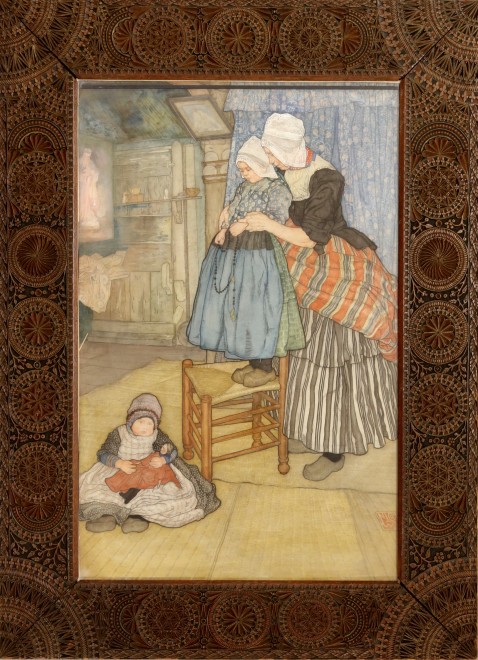91.4 by 58.4 cm.
Provenance
Private Collection, Minneapolis (c. 1960)
Exhibited
Possibly, Dowdeswell and Dowdeswell Gallery, London, c. 1900Catalogue note
Reviews of the monographic exhibitions featuring Nico Jungmann’s work in London in the early 1900s were praiseworthy. The art critic, Alfred Lys Baldry referred to him as a genius in his review for the Magazine of Art in January 1902. Today, however, little is known of this Dutch/Anglo artist and illustrator. Jungmann was born in Amsterdam, studied at the Rijksakademie and was apprenticed to a mural painter at the age of 12. He moved to London in 1893 and eventually became a British citizen. Jungmann was known primarily for his work as an illustrator, especially of travel and topographical books. Among his most noteworthy publications were books on Holland (1904), Norway (1905) and Normandy (1905), with illustrations featuring charming depictions of the people, whose ethnicity and customs he had studied on his frequent travels to these countries. While our painting is not featured in Jungmann’s travel books, it still conveys the same spirit and sensitivity that characterize his depictions of the various people or types, who inspired his book illustrations. As Alfred Lys Baldry further commented in his review: “Indeed, it is not the least of his merits that [Jungmann] presents with absolute accuracy and with rare sympathy the personality of many types of humanity. His rugged old men, wrinkled and weatherworn, his sleek and smiling maidens, his chubby children, stolid in expression and sturdy in build, are always admirably individualized. This sympathy with his subjects is one of the chief sources of his popularity.” (op. cit.)
When compared to other paintings by Jungmann, The Rosary is clearly an outstanding example of his work. It shows not only the artist’s keen interest in draftsmanship (an essential quality for an illustrator) but also his sensitive understanding of local color. This is especially evident in the delicate and subtle palette used in the garments of the figures and the gentle washes that define the room and its furnishings. It brings to mind similar interiors by the more well-known Swedish painter, Carl Larsson, and this may not be a coincidence. The Rosary most likely dates to the early 1900s; fortunately, there still exists a label from Dowdeswell and Dowdeswell Gallery in London on the reverse of our painting, indicating that it may have been included in a Dowdeswell exhibition. Jungmann was a regular exhibitor there beginning in 1899, with later exhibitions recorded in 1900, 1901, 1903 and 1904. It was in the mid 1890’s that Larsson began a series of watercolors showing the interior of his cottage at Sundborn, Sweden. In 1899 the well-known publisher, Albert Bonnier published a book written by Larsson called A Home (Eh Hem), which contained full-page color reproductions of his watercolors. With the proliferation of color reproduction technology, Larsson’s reputation became widely known, and it is very probable that Jungmann was aware of Larsson through this popular publication. Even Jungmann’s trademark monogram is similar to that of Larsson.
The Larsson aesthetic – a return to simplicity, to handicraft and to natural beauty - was partly based on the writings of William Morris and to the British Arts and Crafts movement. Like Larsson, Jungmann was also influenced by this tradition. In fact, he often carved his own frames, including the richly ornamented frame on the The Rosary; the design clearly echoing the patterns of William Morris.




